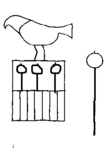Hedju Hor
Hedju Hor was a ruler in northern Egypt from the Predynastic Period.[2][3] His existence is controversial.
| Hedju-Hor | |
|---|---|
| Ḥr.(w)-ḥḏw | |
 Clay cutting of Hedju-Hor hieroglyph[1] | |
| Pharaoh | |
| Reign | Unknown (Early Dynastic Period (Egypt)) |
It is thought by some that his rule was around 3200 BC, though accurate details of his rule are currently unavailable, due to his rule being in prehistory. Almost nothing is known of his rule, as he is known only from inscriptions found in the Delta region and pottery shards from Tura. It has been variously conjectured he was possibly the first pharaoh of Lower Egypt, or the last or that he was a member of Dynasty 0.
Scholarly assessment
Hedju-Hor is only known from two clay jugs from Tura[4] in the eastern Nile Delta and one from Abu Zeidan on the northeastern tip of the Nile Delta, on which his serekh appears.[5]
Egyptologist Wolfgang Helck holds him as a Pharaoh of Dynasty 0 and has identified him with Wash, who is known as the ruler defeated by Narmer on the Narmer Palette,[6] an opinion later shared by Edwin van den Brink.[7] By contrast, Toby Wilkinson[8] and Jochem Kahl both argue that Hedju Hor was not a pre-dynastic Pharaoh but rather a ruler of a small proto-state of the pre-dynastic era and have attributed to him the title King.
Hedju-Hor has no known tomb and is not found in the text of the Palermo Stone, the oldest known king list,[9] further making the claims of both Helck and van den Brink unlikely.
References
- Henry Georg Fischer: Varia Aegyptiaca. In: Journal of the American Research Center in Egypt, Nr. 2. Eisenbrauns, Winona Lake 1963, S. 33, Abb. 1.
- Dr. Günther Eichhorn - Protodynastic Period - 3200 to 3100 BCE.
- Ludwig David Morenz: Bild-Buchstaben und symbolische Zeichen. Die Herausbildung der Schrift der hohen Kultur Altägyptens (= Orbis Biblicus et Orientalis 205). Vandenhoeck & Ruprecht, Göttingen 2004; Academic Press, Fribourg 2004, ISBN 3-7278-1486-1.
- "Ancient Egypt - Dynasty 0". www.narmer.pl. Retrieved 2019-10-06.
- Henry Georg Fischer: Varia Aegyptiaca . In: Journal of the American Research Center in Egypt, No. 2 . Eisenbrauns, Winona Lake 1963, p. 44.
- Helck, Wolfgang (1987). Untersuchungen zur Thinitenzeit. Ägyptologische Abhandlungen 45. Wiesbaden., p.98
- van den Brink, Edwin (1996). "The Incised Serekh-signs of Dynasties 0–1, Part I: Complete Vessels". In Spencer, Alan J. (ed.). Aspects of Early Egypt. London: British Museum Press. pp. 140–158. ISBN 0714109991., p.147
- Toby A.H. Wilkinson: Early Dynastic Egypt - Strategy, Security and Society. Routledge, London 1999, ISBN 0-415-18633-1. page 55-56.
- Hsu, Hsu, Shih-Wei (2010) The Palermo Stone: the Earliest Royal Inscription from Ancient Egypt, Altoriental. Forsch., Akademie Verlag, 37 (2010) 1, 68–89.